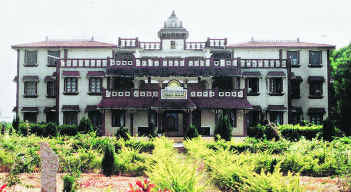
The National Institute of Prakrit Studies and Research - An institute dedicated to the promotion of Prakrit
| Most of the Jain literature is recorded in Prakrit languages |
- In ancient India, Prakrit was the language of the common man
- Jains used the people's language to promote their philosophy
- Ardhamagadhi, Shouraseni and Apabransh are prominent Prakrit languages

ABODE OF KNOWLEDGE:
The National Institute of Prakrit Studies and Research
SHRAVANABELAGOLA: For Jain pilgrims, historians and research scholars visiting this pilgrimage centre for the Mahamastakabhisheka, the National Institute of Prakrit Studies and Research is a major attraction as it provides them with an opportunity to catch a glimpse of rare manuscripts in Prakrit.
According to Jain historians, Prakrit, which means "natural," is used to denote the group of languages that were spoken in ancient India. Jainism is inseparable from Prakrit languages. In ancient India, Sanskrit was spoken only by Brahmins while Prakrit was the language of the common man. Jains used the people's language to promote their philosophy and it is because of this reason that most of the Jain literature is in Prakrit languages.
Ardhamagadhi (the language of the people who lived in Magadha between 600 BC and 100 AD), Shouraseni (the language spoken in the Mathura region; Digambara Jains used this language), Jain Maharashtri (the language in which Agamic Jain literature is found) and Apabransh (used in the medieval period) are some of the prominent Prakrit languages.
As knowledge of the languages is crucial to gain an insight into Jain philosophy, Sreekshetra Shravanabelagola has taken interest in preserving manuscript in Prakrit and encouraging studies and research in the language.
Sri Charukeerthy Bhattaraka Swamiji took keen interest in establishing the institute, which was inaugurated by the then President, Shankar Dayal Sharma, in 1993. It is located near Shravanabelagola on the premises of Shri Dhavala Theertham, and is spread over an area of 50 acres. The institute was established under the aegis of the Shrutakevali Education Trust established by Sri Charukeerthi Bhattaraka Swamiji in 1981 to mark the 1,000th Mahamastakabhisheka. According to the swamiji, the trust was established to protect and propagate "Shrutas," the teachings of the Thirthankaras.
The three-storeyed building of the institute with 12 rooms was constructed at a cost of Rs. 50 lakhs. Books and manuscripts collected from different parts of the country are stored here. The institute is a repository of wisdom encrypted in Prakrit and contains manuscripts, some of which are 500 years old. Hostel facility is also provided to those who are interested in studying Prakrit.
Students here study Prakrit as part of the syllabus. The institute has published the Kannada translations of Dhavala, Jayadhavala and Mahadhavala, the three celebrated commentaries on "Shatkhandaagama," a primordial text on Jain philosophy.
The institute has also published bilingual textbooks in Kannada to facilitate the learning of Prakrit. State- and national-level seminars and workshops are held to focus on the importance and relevance of Prakrit studies.
The all-India conference of Jain scholars and researchers that concluded in Shravanabelagola on January 1 resolved to establish a deemed university at Shravanabelagola to promote Prakrit studies. It also decided to make efforts to strengthen teaching and research in Prakrit.
President A.P.J. Abdul Kalam, who inaugurated the Mahamastakabhisheka celebrations, suggested that Shravanabelagola be made a centre for the study of Jain philosophy, literature, history and mathematics.
The swamiji notes that upgrading the institute into a deemed university will help realise this dream.